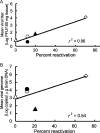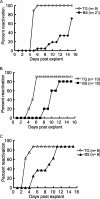Efficient reactivation of latent herpes simplex virus from mouse central nervous system tissues
- PMID: 17005636
- PMCID: PMC1676271
- DOI: 10.1128/JVI.01232-06
Efficient reactivation of latent herpes simplex virus from mouse central nervous system tissues
Abstract
For decades, numerous ex vivo studies have documented that latent herpes simplex virus (HSV) reactivates efficiently from ganglia, but rarely from the central nervous systems (CNS), of mice when assayed by mincing tissues before explant culture, despite the presence of viral genomes in both sites. Here we show that 88% of mouse brain stems reactivated latent virus when they were dissociated into cell suspensions before ex vivo explant culture. The efficient reactivation of HSV from the mouse CNS was demonstrated with more than one viral strain, viral serotype, and mouse strain, further indicating that the CNS can be an authentic latency site for HSV with the potential to cause recurrent disease.
Figures



References
-
- Beffert, U., P. Bertrand, D. Champagne, S. Gauthier, and J. Poirier. 1998. HSV-1 in brain and risk of Alzheimer's disease. Lancet 351:1330-1331. - PubMed
-
- Binstock, T. 2001. Anterior insular cortex: linking intestinal pathology and brain function in autism-spectrum subgroups. Med. Hypoth. 57:714-717. - PubMed
-
- Cabrera, C. V., C. Wohlenberg, H. Openshaw, M. Rey-Mendez, A. Puga, and A. L. Notkins. 1980. Herpes simplex virus DNA sequences in the CNS of latently infected mice. Nature 288:288-290. - PubMed
-
- Cook, M. L., and J. G. Stevens. 1976. Latent herpetic infections following experimental viraemia. J. Gen. Virol. 31:75-80. - PubMed
Publication types
MeSH terms
LinkOut - more resources
Full Text Sources

